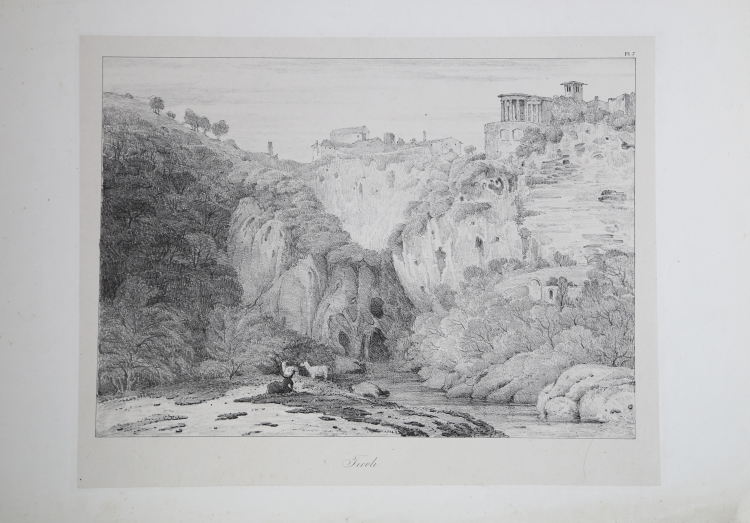



| Reference: | S3465 |
| Author | William LINTON |
| Year: | 1830 |
| Zone: | Tivoli |
| Printed: | London |
| Measures: | 367 x 285 mm |


| Reference: | S3465 |
| Author | William LINTON |
| Year: | 1830 |
| Zone: | Tivoli |
| Printed: | London |
| Measures: | 367 x 285 mm |
Veduta tratta dal celebre "Sketches in Italy: being a selection from upwards of five hundred of the most striking and picturesque scenes in various parts of Piedmont; the Milanese, Venetian, and Roman states; Tuscany; and the Kingdom of Naples. Sketched during a tour in the years 1828 and 1829, and drawn on stone, with historical and descriptive references, a map, and index en route, by William Linton. In two volumes. Vol. I. (II.) - London: published by the author, 19, Blenheim Street; and Downshire Hill Cottage, Hampstead, 1832".
L'opera contiene 96 llitografie, tutte su carta india, e realizzate da W.Day.
Si trattò di una pubblicazione lussuosa, eccellente e rara, con una sottiscrizione originale limitata a 89 nomi.
Il percorso del viaggio in Italia includeva visite a Lugano, Milano, Torino, Genova, Firenze, Roma e dintorni, Napoli, Pompei, Sorrento, Amalfi, Assisi, Perugia, Bologna, Ferrara, Venezia e Padova.
Litografia, in eccellente stato di conservazione. Rara.
William LINTON (Liverpool, 1791 - Londra, 1876)
|
William Linton At the age of sixteen he was placed in a merchant's office. He however did not like the job. For his own pleasure, he started to copy works by Claude Gellee (Lorrain, 1600–1682) and Richard Wilson (1714–1782). Eventually he made art his profession. By 1817 Linton settled in London and started to exhibit at the Royal Academy and British Institution. At that time, his subjects often presented scenery in Scotland and in the North of England, especially in the vicinity of the Lakes.
He took an active part in the founding of the Society of British Artists in 1823-1824 and was its President in 1837. The contemporaries praised Linton as "the new Richard Wilson". In 1832, he published a book ‘Sketches in Italy: being a selection from upwards of five hundred of the most striking and picturesque scenes in various parts of Piedmont: the Milanese, Venetian, and Roman States; Tuscany; and the Kingdom of Naples; sketched during a tour in the years 1828-1829.’(London,1832).
|
William LINTON (Liverpool, 1791 - Londra, 1876)
|
William Linton At the age of sixteen he was placed in a merchant's office. He however did not like the job. For his own pleasure, he started to copy works by Claude Gellee (Lorrain, 1600–1682) and Richard Wilson (1714–1782). Eventually he made art his profession. By 1817 Linton settled in London and started to exhibit at the Royal Academy and British Institution. At that time, his subjects often presented scenery in Scotland and in the North of England, especially in the vicinity of the Lakes.
He took an active part in the founding of the Society of British Artists in 1823-1824 and was its President in 1837. The contemporaries praised Linton as "the new Richard Wilson". In 1832, he published a book ‘Sketches in Italy: being a selection from upwards of five hundred of the most striking and picturesque scenes in various parts of Piedmont: the Milanese, Venetian, and Roman States; Tuscany; and the Kingdom of Naples; sketched during a tour in the years 1828-1829.’(London,1832).
|